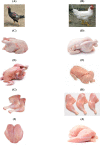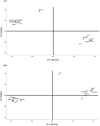The Comparison between Tanzanian Indigenous (Ufipa Breed) and Commercial Broiler (Ross Chicken) Meat on the Physicochemical Characteristics, Collagen and Nucleic Acid Contents
- PMID: 36133634
- PMCID: PMC9478975
- DOI: 10.5851/kosfa.2022.e35
The Comparison between Tanzanian Indigenous (Ufipa Breed) and Commercial Broiler (Ross Chicken) Meat on the Physicochemical Characteristics, Collagen and Nucleic Acid Contents
Abstract
The objective of this study was to characterize the meat quality traits that affect the texture and savory taste of Ufipa indigenous chickens by comparing the proximate composition, physical characteristics, collagen, and nucleic acid contents with those of commercial broilers. It was found that Ufipa chicken breast and thigh meat had a higher protein content (p<0.05) than broiler chicken meat, whereas the fat content was lower (p<0.01). The moisture content of thigh meat was lower in Ufipa chicken meat than in broiler chicken meat (p<0.05). Regarding meat color, broiler chickens had considerably higher L* and b* than Ufipa chickens in both the breast and the thigh meat, except for a* (p<0.01). Regarding water holding capacity, Ufipa chicken breast exhibited higher drip loss but lower thawing and cooking losses than broiler chicken (p<0.01). In contrast, its thigh meat had a much lower drip and thawing losses but higher cooking losses (p<0.01). The shear force of Ufipa chickens' breasts and thighs was higher than that of broiler chickens (p<0.05), while the amount of total collagen in the thigh meat was higher than that of broiler chickens (p<0.05). Additionally, the inosine-5'-monophosphate (IMP) of Ufipa chicken breast and thigh meat was higher than that of broiler meat (p<0.05). The principal component analysis of meat quality traits provides a correlation between the proximate and physical-chemical prosperties of both breeds with some contrast. In conclusion, the present study provides information on healthy food with good-tasting Ufipa indigenous chickens, which offer a promising market due to consumers' preferences.
Keywords: inosine-5’-monophosphate; meat science; native chicken; principal component analysis (PCA).
© Korean Society for Food Science of Animal Resources.
Conflict of interest statement
The authors declare no potential conflicts of interest.
Figures




Similar articles
-
Differences in Physicochemical and Nutritional Properties of Breast and Thigh Meat from Crossbred Chickens, Commercial Broilers, and Spent Hens.Asian-Australas J Anim Sci. 2016 Jun;29(6):855-64. doi: 10.5713/ajas.15.0840. Epub 2015 Dec 23. Asian-Australas J Anim Sci. 2016. PMID: 26954114 Free PMC article.
-
Meat quality traits of four Chinese indigenous chicken breeds and one commercial broiler stock.J Zhejiang Univ Sci B. 2013 Oct;14(10):896-902. doi: 10.1631/jzus.B1300163. J Zhejiang Univ Sci B. 2013. PMID: 24101206 Free PMC article.
-
Sensory and physicochemical characteristics of Japanese jidori chicken (Choshu-Kurokashiwa) and broiler thigh meat: Effect of cooking procedure.Anim Sci J. 2024 Jan-Dec;95(1):e13932. doi: 10.1111/asj.13932. Anim Sci J. 2024. PMID: 38410878
-
Determinants of broiler chicken meat quality and factors affecting them: a review.J Food Sci Technol. 2017 Sep;54(10):2997-3009. doi: 10.1007/s13197-017-2789-z. Epub 2017 Aug 28. J Food Sci Technol. 2017. PMID: 28974784 Free PMC article. Review.
-
A comparative review on Ayam Cemani chicken - A comparison with the most common chicken species in terms of nutritional values, LCA, price and consumer acceptance.Trop Anim Health Prod. 2024 May 11;56(4):161. doi: 10.1007/s11250-024-03980-6. Trop Anim Health Prod. 2024. PMID: 38733430 Free PMC article. Review.
Cited by
-
The Effect of Different Freezing and Thawing Methods on Physicochemical, Sensory, and Flavor Characteristics of Korean Native Chicken Breast.Food Sci Anim Resour. 2025 Mar;45(2):573-597. doi: 10.5851/kosfa.2024.e110. Epub 2025 Mar 1. Food Sci Anim Resour. 2025. PMID: 40093627 Free PMC article.
-
Mathematical modeling for freshness/spoilage of chicken breast using chemometric analysis.Curr Res Food Sci. 2023 Sep 10;7:100590. doi: 10.1016/j.crfs.2023.100590. eCollection 2023. Curr Res Food Sci. 2023. PMID: 37727874 Free PMC article.
-
Characterization of urban production of roadrunner (indigenous) chicken in Harare, Zimbabwe.Trop Anim Health Prod. 2025 Apr 3;57(3):155. doi: 10.1007/s11250-025-04397-5. Trop Anim Health Prod. 2025. PMID: 40178633
-
A Comparison of the Meat Quality, Nutritional Composition, Carcass Traits, and Fiber Characteristics of Different Muscular Tissues between Aged Indigenous Chickens and Commercial Laying Hens.Foods. 2023 Oct 7;12(19):3680. doi: 10.3390/foods12193680. Foods. 2023. PMID: 37835333 Free PMC article.
-
Nutrition and Flavor Evaluation of Amino Acids in Guangyuan Grey Chicken of Different Ages, Genders and Meat Cuts.Animals (Basel). 2023 Apr 2;13(7):1235. doi: 10.3390/ani13071235. Animals (Basel). 2023. PMID: 37048491 Free PMC article.
References
-
- Abdullah AY, Matarneh SK. Broiler performance and the effects of carcass weight, broiler sex and postchill carcass aging duration on breast fillet quality characteristics. J Appl Poult Res. 2010;19:46–58. doi: 10.3382/japr.2009-00079. - DOI
-
- Ahn DH, Park SY. Studies on components related to taste such as free amino acids and nucleotides in Korean native chicken meat. J Korean Soc Food Sci Nutr. 2002;31:547–552. doi: 10.3746/jkfn.2002.31.4.547. - DOI
-
- AOAC . Official methods of analysis of AOAC International. 16th. AOAC International; Washington, DC, USA: 1997.
LinkOut - more resources
Full Text Sources

